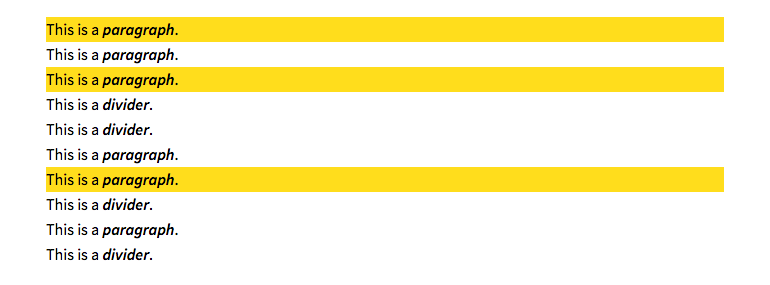nth-child vs nth-of-type
The nth-child() and nth-of-type() selectors are “structural” pseudo-classes, which are classes that allow us to select elements based on information within the document tree that cannot typically be represented by other simple selectors.
In the case of nth-child() and nth-of-type(), the extra information is the element’s position in the document tree in relation to its parent and siblings. Although these two pseudo-classes are very similar, they work in fundamentally different ways.
How nth-child() Works #
The nth-child() pseudo-class is used to match an element based on a number, which represents the element’s position amongst it’s siblings. More specifically, the number represents the number of siblings that exist before the element in the document tree (minus 1).
This number is expressed as a function, an+b, where n is the index, and a and b are any integers we pass. For example, to select every element, we could write any of the following -
:nth-child(1n+0) { /* styles */ }
:nth-child(n+0) { /* styles */ }
:nth-child(1n) { /* styles */ }In addition to using this function, we can pass a single integer, e.g. :nth-child(1) or use one of the set keywords, odd or even. These keywords are alternatives for writing out the functional notation for selecting every odd or even numbered element.
:nth-child(odd) { /* styles for odd elements */ }
:nth-child(2n+1) { /* styles for odd elements */ }
:nth-child(even) { /* styles for even elements */ }
:nth-child(2n+0) { /* styles for even elements */ }When using :nth-child() on its own, it is simple enough to predict which element will be selected. For example, using this markup -
<div class="example">
<p>This is a <em>paragraph</em>.</p>
<p>This is a <em>paragraph</em>.</p>
<p>This is a <em>paragraph</em>.</p>
<div>This is a <em>divider</em>.</div>
<div>This is a <em>divider</em>.</div> <!-- Element to select -->
<p>This is a <em>paragraph</em>.</p>
<p>This is a <em>paragraph</em>.</p>
<div>This is a <em>divider</em>.</div>
<p>This is a <em>paragraph</em>.</p>
<div>This is a <em>divider</em>.</div>
</div>If we wanted to select the fifth element, the div, we could simply write the following -
.example :nth-child(5) { background: #ffdb3a; }
However, unexpected results may occur when there are multiple types of elements, and we need to combine the :nth-child() pseudo-class with type or class selectors. For example, to select that same div element again, we may be tempted to write the following -
.example div:nth-child(2) { background: #ffdb3a; } Note - Will not work
The reason this will not work is because the element that selector is targeting does not actually exist. Using the above selector, the user agent will go through the following steps -
- Select all the child elements of
.example - Find the second element in that list, irrespective of type
- Check if that element is a type of
div
Since the second element in the document tree is a paragraph, not a div, nothing is selected. If we wanted to select the second div element, we would have to use the nth-of-type() pseudo-class.
How nth-of-type() Works #
The nth-of-type() pseudo-class, like nth-child(), is used to match an element based on a number. This number, however, represents the element's position within only those of its siblings that are of the same element type.
This number can also be expressed as a function, or using the keywords even or odd. Using the example markup above, we can select all the odd paragraphs by writing -
.example p:nth-of-type(odd) { background: #ffdb3a; }
When we use this selector, the user agent goes through the following steps -
- Select all the child elements of
.examplethat are of the typep - Create a new list of only these elements
- Select the odd numbers from that list
Because of this, we can now select the second div, the fifth child of .example -
.example div:nth-of-type(2) { /* styles */ } Other "nth" Pseudo-Classes #
Besides nth-child() and nth-of-type(), there are a number of other structural pseudo-classes we can use to select elements based on their position within their siblings. Like nth-child() and nth-of-type(), they fall into two groups - the ones that are type-independent, like nth-child(), and the ones that are type-dependent, like nth-of-type().
| Type-independent | Type-dependent |
|---|---|
| nth-child() | nth-of-type() |
| nth-last-child() | nth-last-of-type() |
| first-child() | first-of-type() |
| last-child() | last-of-type() |
| only-child() | only-of-type() |
Counting From The End - nth-last-child() vs nth-last-of-type() #
These pseudo-classes work like nth-child() and nth-of-type(), but they begin counting from the last element in the group of siblings instead of the first.
.example :nth-last-child(1) { background: #a6cae7; }
.example p:nth-last-of-type(1) { background: #ffdb3a; } The First Element - first-child() vs first-of-type() #
The first-child() and first-of-type() pseudo-classes select the first element. They can be thought of as using the nth-child() and nth-of-type() pseudo-classes, but simply passing in a value of 1.
.example :first-child() { /* styles */ }
.example :nth-child(1) { /* styles */ } /* same as above */
.example :first-of-type() { /* styles */ }
.example :nth-of-type(1) { /* styles */ } /* same as above */The Last Element - last-child() vs last-of-type() #
These are the opposite to the first-child() and first-of-type() pseudo-classes. They can be thought of as using the nth-last-child() and nth-last-of-type() pseudo-classes, but passing in a value of 1.
.example :last-child() { /* styles */ }
.example :nth-last-child(1) { /* styles */ } /* same as above */
.example :last-of-type() { /* styles */ }
.example :nth-last-of-type(1) { /* styles */ } /* same as above */The Only Element - only-child() vs only-of-type() #
Finally, these pseudo-classes will select an element that is the only child. For only-child(), the element must be literally the only child of it’s parent, regardless of type. For only-of-type(), the element need only be the only child of its type.
.example :only-child() { /* styles */ }
.example p:only-of-type() { /* styles */ }